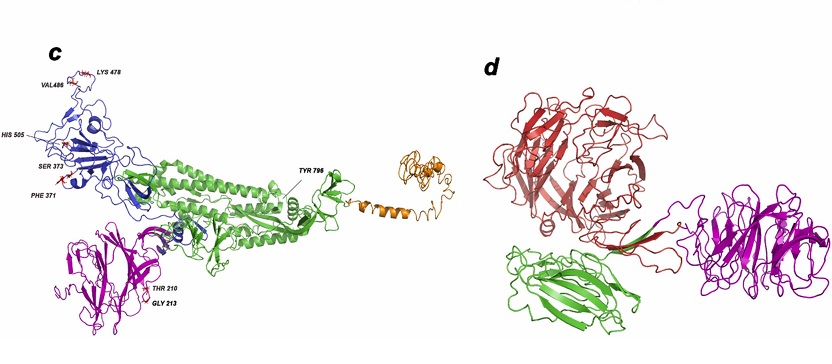Y505H Spike Mutation Found In New SARS-CoV-2 Sub-Lineages Circulating In Pakistan Enhances Binding With Both ACE2 And NRP1 Receptors!
SARS-CoV-2 News - SARS-CoV-2 Y505H Spike Mutation - ACE2 - NRP1 Receptors Jul 25, 2023 2 years, 3 months, 2 weeks, 2 days, 7 minutes ago
Pakistani study reveals that I210T, V213G, S371F, S373P, T478K, F486V, Y505, D796Y mutations enhances SARS-CoV-2 binding with ACE2 and NRP1 and enhances viral transmission.
SARS-CoV-2 News: Since the emergence of SARS-CoV-2 in late 2019, the world has been grappling with an unprecedented global health crisis. The virus responsible for COVID-19 has rapidly spread across continents. As the virus continues to evolve, new variants have emerged, raising concerns about their impact on transmission and the effectiveness of existing countermeasures.
 C. Mutated SARS-CoV-2 Spike Protein and D. NRP1 receptor
C. Mutated SARS-CoV-2 Spike Protein and D. NRP1 receptor
In a recent study conducted at the University of the Punjab, Lahore, researchers have shed light on specific mutations found in Pakistani SARS-CoV-2 strains circulating in the country. These mutations appear to enhance the virus's binding affinity with human receptors ACE2 and NRP1, potentially leading to increased viral transmission.
It should be noted that the NRP1 receptors are also extensively found in the Brain and Central Nervous System and also the neurovascular system besides elsewhere in the human body.
The Ever-Evolving SARS-CoV-2 Virus
The SARS-CoV-2 virus, belonging to the coronavirus family, has proven to be a formidable adversary. Initially causing a severe respiratory illness called COVID-19, the virus has caused millions of deaths worldwide and left survivors grappling with long-term health issues. Its ability to spread through physical contact and respiratory droplets has facilitated its rapid transmission among individuals.
The virus's structure comprises rounded particles enveloped in glycoproteins, and it carries advanced antigenic epitopes. To infect the human body, SARS-CoV-2 employs its spike protein to attach to the ACE2 receptor. This crucial step allows the virus to gain entry and unleash its harmful effects. Additionally, NRP1 (Neuropilin-1) is another receptor that facilitates viral proliferation in the human body.
Identifying New Variants in SARS-CoV-2
In light of the virus's rapid evolution, several variants have emerged, including the infamous D614G mutation, which has been widely reported in various
SARS-CoV-2 News coverages. The Pakistani study set out to identify and analyze new variants in the SARS-CoV-2 spike protein. The researchers used advanced in-silico mutational tools to conduct their investigation, which provided valuable insights into the potential effects of these mutations on protein structure, function, and interactions with human receptors.
Unveilin
g the Impact of Mutations
The research yielded significant findings, as the scientists discovered several variants in the spike protein of Pakistani SARS-CoV-2 strains.
The In-silico mutational and molecular interaction analysis revealed that the I210T, V213G, S371F, S373P, T478K, F486V, Y505H and D796Y have a structural effect on the SARS-CoV-2 spike protein, which enhanced the SARS-CoV-2 attachment with ACE2 and NRP1. These new variants can cause more diverse effects in the near future.
Among these variants, Y505H raised particular concerns due to its potential impact on protein function. This mutation was previously unreported and appeared to enhance the spike protein's binding affinity with human receptors ACE2 and NRP1 at an alarming rate.
Implications and Future Directions
The observed mutations suggest that SARS-CoV-2 continues to adapt and evolve, potentially to overcome immune responses or environmental pressures.
Consequently, these changes may influence the virus's transmissibility and pathogenicity, potentially affecting the efficacy of existing therapies and vaccines.
The study's molecular dynamics docking, MMGBSA, and MD simulation analyses provided further insights, indicating that spike protein variants exhibited increased binding affinity with human receptors ACE2 and NRP1. Such interactions can have far-reaching implications for viral transmission and pathogenicity.
Cautionary Notes
As compelling as the findings may be, it is essential to approach them with caution. The study relied on in-silico analyses, which are simulations based on computational models. While valuable for hypothesis generation, real-world validation through in-vitro and in-vivo experiments is vital to confirm the results.
Conclusion
The Pakistani study has illuminated critical aspects of SARS-CoV-2's evolution and its interaction with human receptors. The identified spike protein mutations may play a pivotal role in enhancing viral transmission, necessitating ongoing surveillance and research to combat the virus effectively.
As scientists and healthcare professionals remain vigilant, this invaluable knowledge can guide the development of strategies to control the virus's spread and inform the creation of more effective treatments and vaccines. Ultimately, understanding how the virus evolves and adapts to human hosts is essential in humanity's ongoing battle against COVID-19.
The study findings were published in the peer reviewed Journal of Infection and Public Health.
https://www.sciencedirect.com/science/article/pii/S1876034123002460
For the latest
SARS-CoV-2 News, keep on logging to Thailand Medical News.
